Dendrobium speciosum is one of the world's most underrated and exciting of orchids. They are capable of producing possibly the largest display plants and most spectacular shows of mass blooming of any known orchid. Extraordinarily tough, hardy and drought tolerant it should be one of the most cultivated plants ever! It can tolerate near frost to temperatures over 45°c without severe damage.
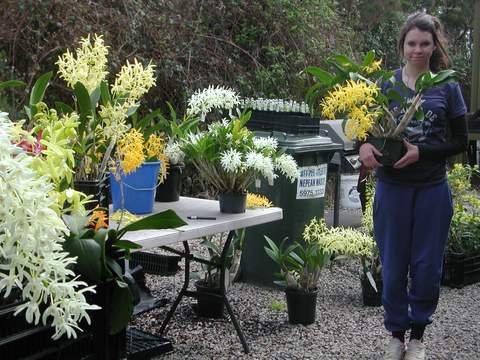
This orchid is native to a vast section of Australia ranging from Mallacoota (37°33'S) in South-East Victoria to the tropical conditions up past Cairns (16°57′S). Because it is found over such a vast region, botanists have broken the species apart into many subspecies or varieties. It seems every few years they change names again, so we will mainly use the oldest and most accepted names in this guide.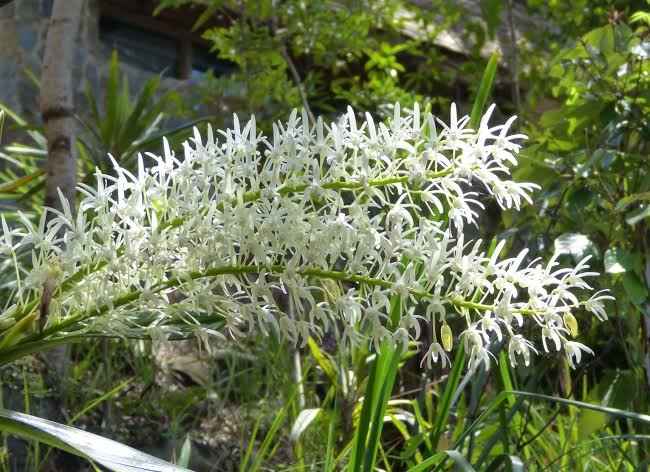
Growing under harsh dry and bright Australian conditions it is the perfect orchid for garden planting in tubs or even half wine barrels. Anywhere worldwide that has similar conditions to south-eastern Australia will be able to grow this orchid with ease. Dendrobium speciosum is particularly suited for growing in southern Italy, Greece, Portugal, Spain, southern France, and California USA.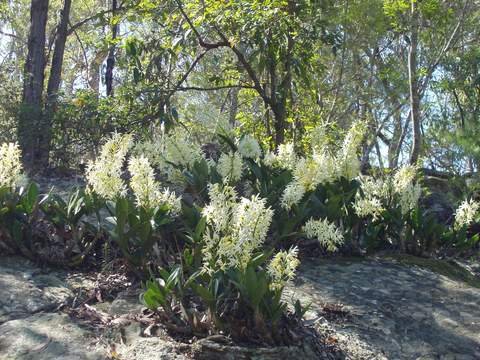
This is an orchid that thrives on low-medium humidity, bright to very bright light and an open well drained pot with orchid compost.
In almost every occasion I have seen this orchid in the wild, it is growing on granite cliff faces or boulders in open grassy paddocks. The photo below shows just how open bright and exposed these magnificent orchids require. They are huge growers, so in time they may require a giant tub or preferment position in the garden.

Very bright, open, breezy positions seem to be the key to mass blooming. Speciosums can be acclimatised to take 100% full-sun if slowly positioned into brighter and brighter light from late winter onwards. It is in these full sun positions that they will bloom annually without fail. A constantly moist root system is also important, as in natural cliff faces they live on weep moisture constantly.

The speciosum's root systems are always covered with a blanket of moist ferns and mosses. Certain African introduced weeds also grow along with speciosums. A good indicater plant is Plectranthus sp. Wherever this grows, speciosum will too!
Growing dendrobium speciosum is simple. Avoid frosts, unaccustomed hot sun, too much shade (make sure you can see a shadow when placing hand above foliage) and temperatures above 36c if possible.
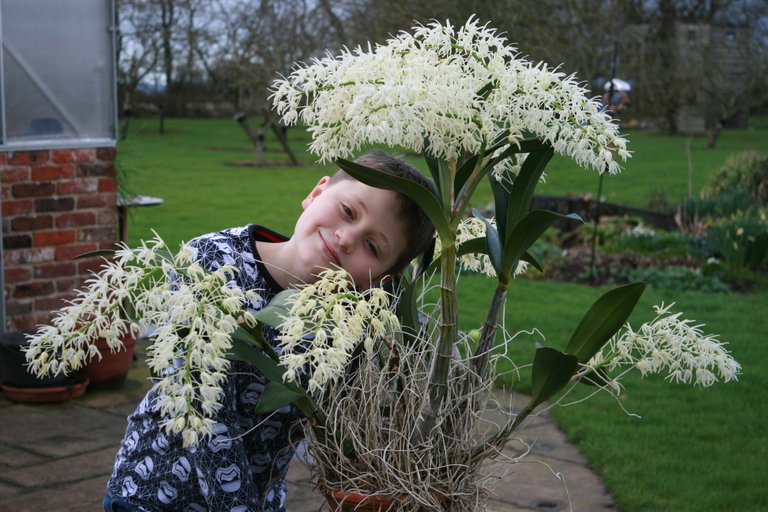
The orchid trade in Australia has sold speciosum for over 30 years, and much work has been done hybridising many different colour forms and shapes, using the various sub species from up and down the east coast. The most desirable hybrid line bred speciosum is one with intense rich golden yellow colour but not to large in the canes or pseudobulbs.
The far Southern form known as dendrobium speciosum var speciosum is the easiest to grow (and most tolerant of abuse). The deepest colour forms are unusual variants of speciosum var grandiflorum, these may be rich golden yellow, and sometimes in full sun almost a golden orange. This colour form is extremely rare and known from only a very few parents such as "Kroombit Tops" "Mt Larcom Gold" and "Beranghi Gold". Do not expect the deepest colour forms to come easily or cheaply. Generally a good rich daffodil yellow is to be expected.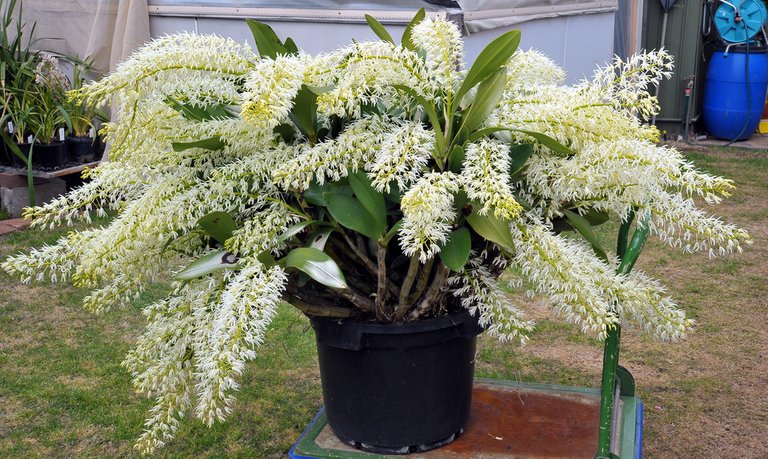
In nature most clones are a pale lemon or yellow/cream in colour, very rarely are true clear whites seen. These are the rarest colour form. Look for the parent "National White" when trying to obtain a white flowering form. One of the rarest natural forms 'Boreale" from Nth Queensland tends also to be clear white.
The shortest caned forms are the pedunculatum forms from furthest north Queensland. They may have fully mature blooming sized canes at only 3" tall! When bred with the largest caned grandiflorums, it is possible to obtain deep colours but on relatively tiny canes (bonsai)!
For cultivation avoid the hillii variety as this produces clawed tiny blooms in pale creams. Also it produces giant canes with disproportionately tiny blooms. Many of these are exported as grandiflorums, so buyers beware.
We usually sell 50mm tube sized dendrobium speciosum that are 18 months to two years ex vitro. These are 3" tall and will take about 6 years to bloom.
An 80mm size is about 3 years old and about 4-5 years from blooming
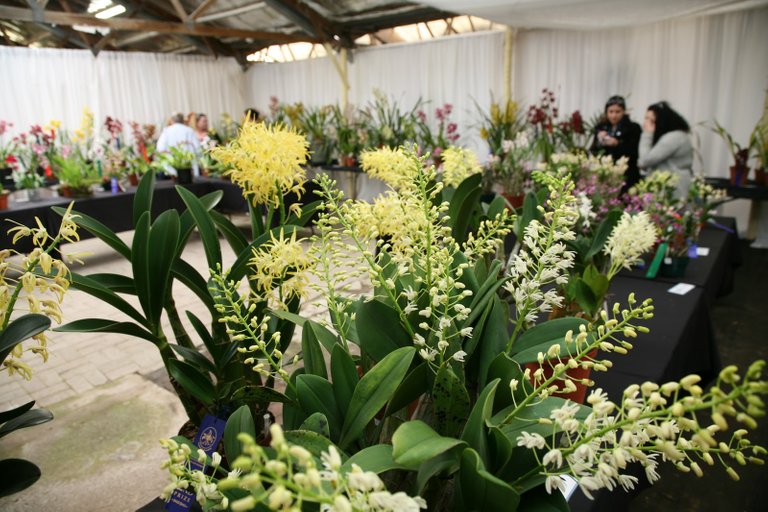 Our 100mm advanced size is about 3-4 years out of the bottle and about 2-3 years from blooming.
Our 100mm advanced size is about 3-4 years out of the bottle and about 2-3 years from blooming.
Pots should always have excellent drainage and not be too large in comparison to the orchid. As they are vigorous growers, re pot annually. The compost should be open well drained and have about 25% rock present.
Feeding is with Peters Excel Hi K 5 grams (1 teaspoon) per 10 litres.
They are virtually free of pests, as their foliage is like heavy gauge plastic (but may occasionally get scale insect)[source](Dendrobium speciosum is one of the world's most underrated and exciting of orchids. They are capable of producing possibly the largest display plants and most spectacular shows of mass blooming of any known orchid. Extraordinarily tough, hardy and drought tolerant it should be one of the most cultivated plants ever! It can tolerate near frost to temperatures over 45°c without severe damage.
This orchid is native to a vast section of Australia ranging from Mallacoota (37°33'S) in South-East Victoria to the tropical conditions up past Cairns (16°57′S). Because it is found over such a vast region, botanists have broken the species apart into many subspecies or varieties. It seems every few years they change names again, so we will mainly use the oldest and most accepted names in this guide.
Growing under harsh dry and bright Australian conditions it is the perfect orchid for garden planting in tubs or even half wine barrels. Anywhere worldwide that has similar conditions to south-eastern Australia will be able to grow this orchid with ease. Dendrobium speciosum is particularly suited for growing in southern Italy, Greece, Portugal, Spain, southern France, and California USA.
This is an orchid that thrives on low-medium humidity, bright to very bright light and an open well drained pot with orchid compost.
In almost every occasion I have seen this orchid in the wild, it is growing on granite cliff faces or boulders in open grassy paddocks. The photo below shows just how open bright and exposed these magnificent orchids require. They are huge growers, so in time they may require a giant tub or preferment position in the garden.
Very bright, open, breezy positions seem to be the key to mass blooming. Speciosums can be acclimatised to take 100% full-sun if slowly positioned into brighter and brighter light from late winter onwards. It is in these full sun positions that they will bloom annually without fail. A constantly moist root system is also important, as in natural cliff faces they live on weep moisture constantly.
The speciosum's root systems are always covered with a blanket of moist ferns and mosses. Certain African introduced weeds also grow along with speciosums. A good indicater plant is Plectranthus sp. Wherever this grows, speciosum will too!
Growing dendrobium speciosum is simple. Avoid frosts, unaccustomed hot sun, too much shade (make sure you can see a shadow when placing hand above foliage) and temperatures above 36c if possible.
The orchid trade in Australia has sold speciosum for over 30 years, and much work has been done hybridising many different colour forms and shapes, using the various sub species from up and down the east coast. The most desirable hybrid line bred speciosum is one with intense rich golden yellow colour but not to large in the canes or pseudobulbs.
The far Southern form known as dendrobium speciosum var speciosum is the easiest to grow (and most tolerant of abuse). The deepest colour forms are unusual variants of speciosum var grandiflorum, these may be rich golden yellow, and sometimes in full sun almost a golden orange. This colour form is extremely rare and known from only a very few parents such as "Kroombit Tops" "Mt Larcom Gold" and "Beranghi Gold". Do not expect the deepest colour forms to come easily or cheaply. Generally a good rich daffodil yellow is to be expected.
In nature most clones are a pale lemon or yellow/cream in colour, very rarely are true clear whites seen. These are the rarest colour form. Look for the parent "National White" when trying to obtain a white flowering form. One of the rarest natural forms 'Boreale" from Nth Queensland tends also to be clear white.
The shortest caned forms are the pedunculatum forms from furthest north Queensland. They may have fully mature blooming sized canes at only 3" tall! When bred with the largest caned grandiflorums, it is possible to obtain deep colours but on relatively tiny canes (bonsai)!
For cultivation avoid the hillii variety as this produces clawed tiny blooms in pale creams. Also it produces giant canes with disproportionately tiny blooms. Many of these are exported as grandiflorums, so buyers beware.
We usually sell 50mm tube sized dendrobium speciosum that are 18 months to two years ex vitro. These are 3" tall and will take about 6 years to bloom.
An 80mm size is about 3 years old and about 4-5 years from blooming
Our 100mm advanced size is about 3-4 years out of the bottle and about 2-3 years from blooming.
Pots should always have excellent drainage and not be too large in comparison to the orchid. As they are vigorous growers, re pot annually. The compost should be open well drained and have about 25% rock present.
Feeding is with Peters Excel Hi K 5 grams (1 teaspoon) per 10 litres.
They are virtually free of pests, as their foliage is like heavy gauge plastic (but may occasionally get scale insect)source
Comment is far too long. Maximum 200 words, thanks.
Ok sir